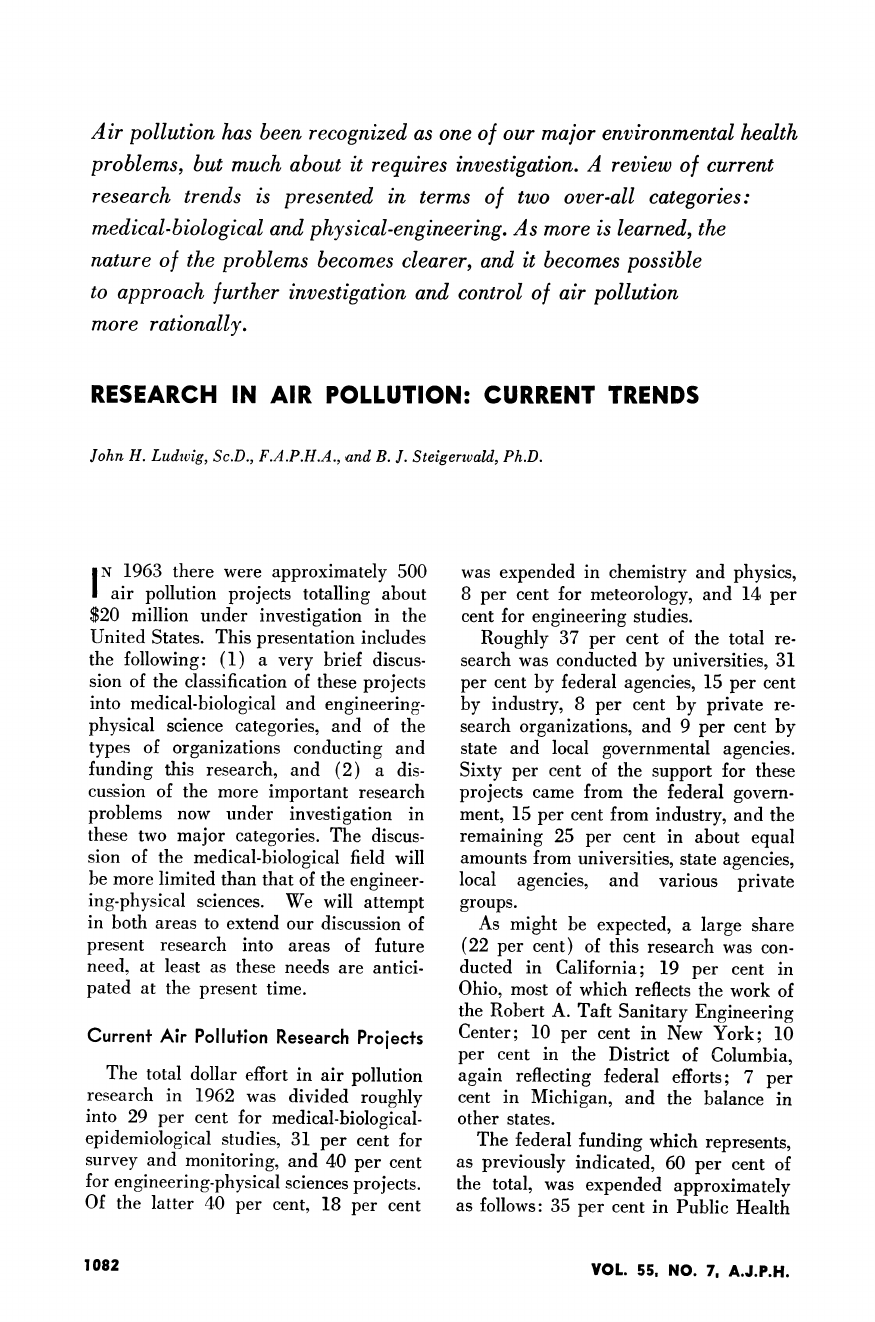
Air
pollution
has
been
recognized
as
one
of
our
major
environmental
health
problems,
but
much
about
it
requires
investigation.
A
review
of
current
research
trends
is
presented
in
terms
of
two
over-all
categories:
medical-biological
and
physical-engineering.
As
more
is
learned,
the
nature
of
the
problems
becomes
clearer,
and
it
becomes
possible
to
approach
further
investigation
and
control
of
air
pollution
more
rationally.
RESEARCH
IN
AIR
POLLUTION:
CURRENT
TRENDS
John
H.
Ludwvig,
Sc.D.,
F.A.P.H.A.,
and
B.
J.
Steigerwald,
Ph.D.
IN
1963
there
were
approximately
500
air
pollution
projects
totalling
about
$20
million
under
investigation
in
the
United
States.
This
presentation
includes
the
following:
(1)
a
very
brief
discus-
sion
of
the
classification
of
these
projects
into
medical-biological
and
engineering-
physical
science
categories,
and
of
the
types
of
organizations
conducting
and
funding
this
research,
and
(2)
a
dis-
cussion
of
the
more
important
research
problems
now
under
investigation
in
these
two
major
categories.
The
discus-
sion
of
the
medical-biological
field
will
be
more
limited
than
that
of
the
engineer-
ing-physical
sciences.
We
will
attempt
in
both
areas
to
extend
our
discussion
of
present
research
into
areas
of
future
need,
at
least
as
these
needs
are
antici-
pated
at
the
present
time.
Current
Air
Pollution
Research
Projects
The
total
dollar
effort
in
air
pollution
research
in
1962
was
divided
roughly
into
29
per
cent
for
medical-biological-
epidemiological
studies,
31
per
cent
for
survey
and
monitoring,
and
40
per
cent
for
engineering-physical
sciences
projects.
Of
the
latter
40
per
cent,
18
per
cent
was
expended
in
chemistry
and
physics,
8
per
cent
for
meteorology,
and
14
per
cent
for
engineering
studies.
Roughly
37
per
cent
of
the
total
re-
search
was
conducted
by
universities,
31
per
cent
by
federal
agencies,
15
per
cent
by
industry,
8
per
cent
by
private
re-
search
organizations,
and
9
per
cent
by
state
and
local
governmental
agencies.
Sixty
per
cent
of
the
support
for
these
projects
came
from
the
federal
govern-
ment,
15
per
cent
from
industry,
and
the
remaining
25
per
cent
in
about
equal
amounts
from
universities,
state
agencies,
local
agencies,
and
various
private
groups.
As
might
be
expected,
a
large
share
(22
per
cent)
of
this
research
was
con-
ducted
in
California;
19
per
cent
in
Ohio,
most
of
which
reflects
the
work
of
the
Robert
A.
Taft
Sanitary
Engineering
Center;
10
per
cent
in
New
York;
10
per
cent
in
the
District
of
Columbia,
again
reflecting
federal
efforts;
7
per
cent
in
Michigan,
and
the
balance
in
other
states.
The
federal
funding
which
represents,
as
previously
indicated,
60
per
cent
of
the
total,
was
expended
approximately
as
follows:
35
per
cent
in
Public
Health
VOL.
55.
NO.
7.
A.J.P.H.
1
082
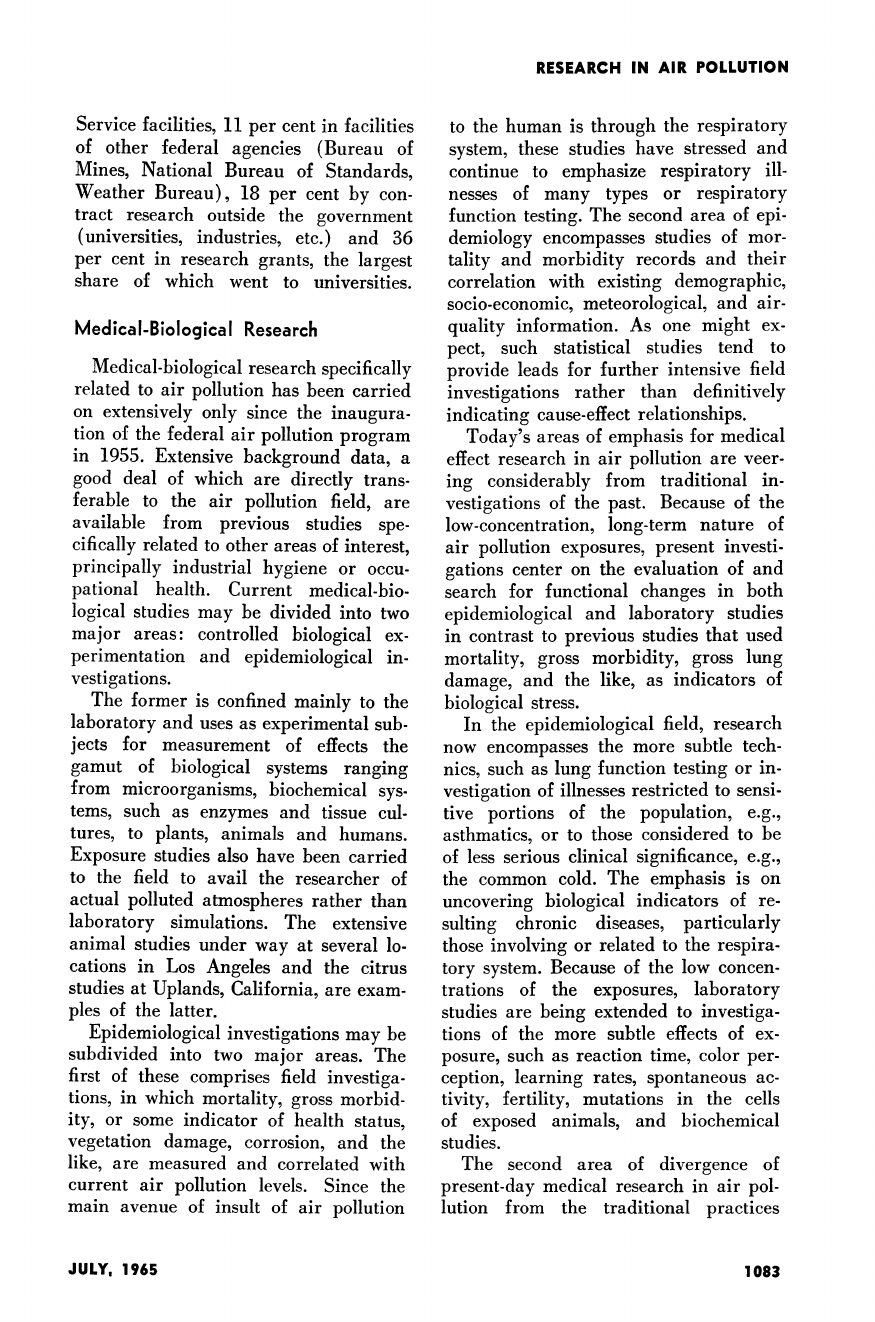
RESEARCH
IN
AIR
POLLUTION
Service
facilities,
11
per
cent
in
facilities
of
other
federal
agencies
(Bureau
of
Mines,
National
Bureau
of
Standards,
Weather
Bureau),
18
per
cent
by
con-
tract
research
outside
the
government
(universities,
industries,
etc.)
and
36
per
cent
in
research
grants,
the
largest
share
of
which
went
to
universities.
Medical-Biological
Research
Medical-biological
research
specifically
related
to
air
pollution
has
been
carried
on
extensively
only
since
the
inaugura-
tion
of
the
federal
air
pollution
program
in
1955.
Extensive
background
data,
a
good
deal
of
which
are
directly
trans-
ferable
to
the
air
pollution
field,
are
available
from
previous
studies
spe-
cifically
related
to
other
areas
of
interest,
principally
industrial
hygiene
or
occu-
pational
health.
Current
medical-bio-
logical
studies
may
be
divided
into
two
major
areas:
controlled
biological
ex-
perimentation
and
epidemiological
in-
vestigations.
The
former
is
confined
mainly
to
the
laboratory
and
uses
as
experimental
sub-
jects
for
measurement
of
effects
the
gamut
of
biological
systems
ranging
from
microorganisms,
biochemical
sys-
tems,
such
as
enzymes
and
tissue
cul-
tures,
to
plants,
animals
and
humans.
Exposure
studies
also
have
been
carried
to
the
field
to
avail
the
researcher
of
actual
polluted
atmospheres
rather
than
laboratory
simulations.
The
extensive
animal
studies
under
way
at
several
lo-
cations
in
Los
Angeles
and
the
citrus
studies
at
Uplands,
California,
are
exam-
ples
of
the
latter.
Epidemiological
investigations
may
be
subdivided
into
two
major
areas.
The
first
of
these
comprises
field
investiga-
tions,
in
which
mortality,
gross
morbid-
ity,
or
some
indicator
of
health
status,
vegetation
damage,
corrosion,
and
the
like,
are
measured
and
correlated
with
current
air
pollution
levels.
Since
the
main
avenue
of
insult
of
air
pollution
to
the
human
is
through
the
respiratory
system,
these
studies
have
stressed
and
continue
to
emphasize
respiratory
ill-
nesses
of
many
types
or
respiratory
function
testing.
The
second
area
of
epi-
demiology
encompasses
studies
of
mor-
tality
and
morbidity
records
and
their
correlation
with
existing
demographic,
socio-economic,
meteorological,
and
air-
quality
information.
As
one
might
ex-
pect,
such
statistical
studies
tend
to
provide
leads
for
further
intensive
field
investigations
rather
than
definitively
indicating
cause-effect
relationships.
Today's
areas
of
emphasis
for
medical
effect
research
in
air
pollution
are
veer-
ing
considerably
from
traditional
in-
vestigations
of
the
past.
Because
of
the
low-concentration,
long-term
nature
of
air
pollution
exposures,
present
investi-
gations
center
on
the
evaluation
of
and
search
for
functional
changes
in
both
epidemiological
and
laboratory
studies
in
contrast
to
previous
studies
that
used
mortality,
gross
morbidity,
gross
lung
damage,
and
the
like,
as
indicators
of
biological
stress.
In
the
epidemiological
field,
research
now
encompasses
the
more
subtle
tech-
nics,
such
as
lung
function
testing
or
in-
vestigation
of
illnesses
restricted
to
sensi-
tive
portions
of
the
population,
e.g.,
asthmatics,
or
to
those
considered
to
be
of
less
serious
clinical
significance,
e.g.,
the
common
cold.
The
emphasis
is
on
uncovering
biological
indicators
of
re-
sulting
chronic
diseases,
particularly
those
involving
or
related
to
the
respira-
tory
system.
Because
of
the
low
concen-
trations
of
the
exposures,
laboratory
studies
are
being
extended
to
investiga-
tions
of
the
more
subtle
effects
of
ex-
posure,
such
as
reaction
time,
color
per-
ception,
learning
rates,
spontaneous
ac-
tivity,
fertility,
mutations
in
the
cells
of
exposed
animals,
and
biochemical
studies.
The
second
area
of
divergence
of
present-day
medical
research
in
air
pol-
lution
from
the
traditional
practices
JULY,
1965
1
083
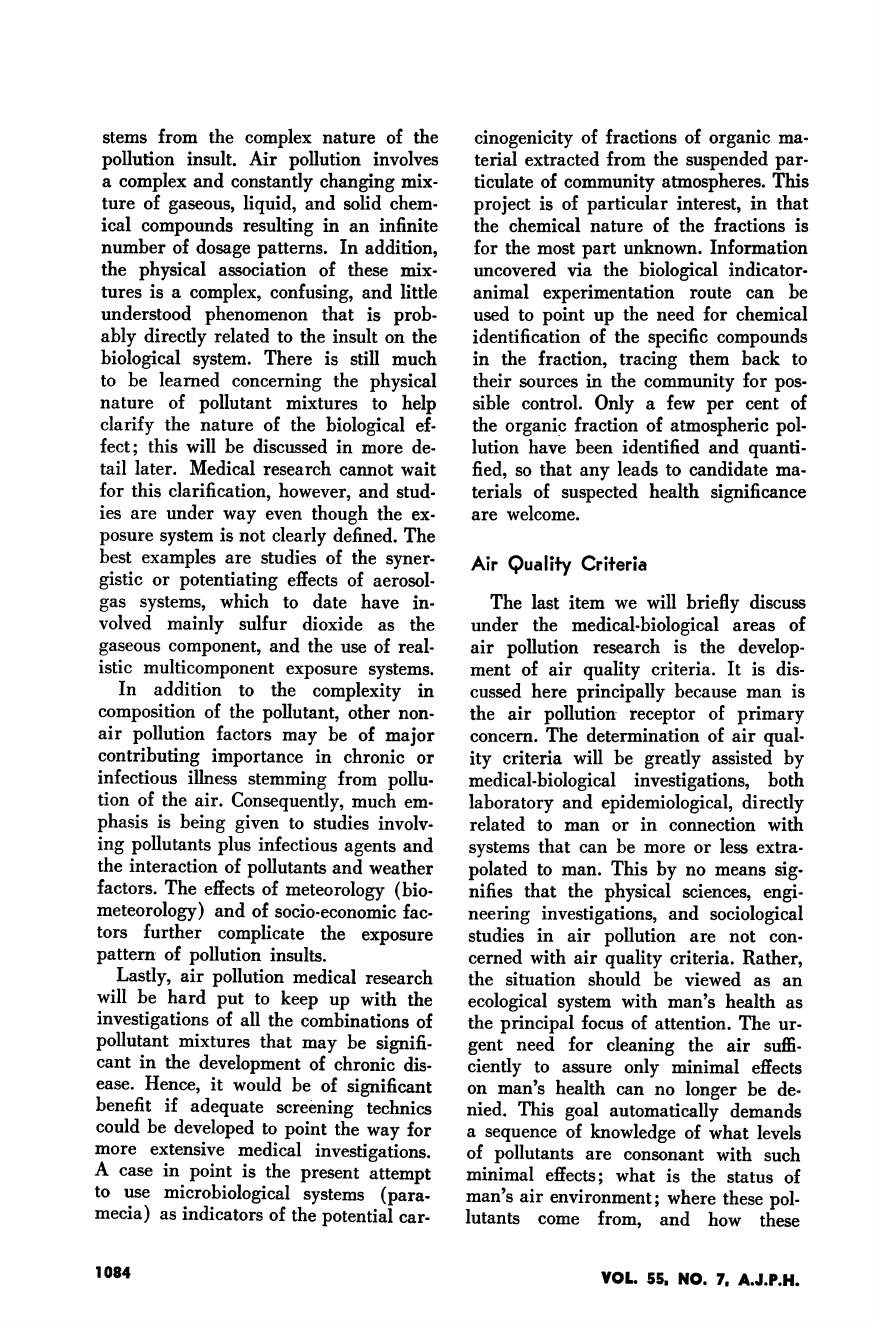
stems
from
the
complex
nature
of
the
pollution
insult.
Air
pollution
involves
a
complex
and
constantly
changing
mix-
ture
of
gaseous,
liquid,
and
solid
chem-
ical
compounds
resulting
in
an
infinite
number
of
dosage
patterns.
In
addition,
the
physical
association
of
these
mix-
tures
is
a
complex,
confusing,
and
little
understood
phenomenon
that
is
prob-
ably
directly
related
to
the
insult
on
the
biological
system.
There
is
still
much
to
be
learned
concerning
the
physical
nature
of
pollutant
mixtures
to
help
clarify
the
nature
of
the
biological
ef-
fect;
this
will
be
discussed
in
more
de-
tail
later.
Medical
research
cannot
wait
for
this
clarification,
however,
and
stud-
ies
are
under
way
even
though
the
ex-
posure
system
is
not
clearly
defined.
The
best
examples
are
studies
of
the
syner-
gistic
or
potentiating
effects
of
aerosol-
gas
systems,
which
to
date
have
in-
volved
mainly
sulfur
dioxide
as
the
gaseous
component,
and
the
use
of
real-
istic
multicomponent
exposure
systems.
In
addition
to
the
complexity
in
composition
of
the
pollutant,
other
non-
air
pollution
factors
may
be
of
major
contributing
importance
in
chronic
or
infectious
illness
stemming
from
pollu-
tion
of
the
air.
Consequently,
much
em-
phasis
is
being
given
to
studies
involv-
ing
pollutants
plus
infectious
agents
and
the
interaction
of
pollutants
and
weather
factors.
The
effects
of
meteorology
(bio-
meteorology)
and
of
socio-economic
fac-
tors
further
complicate
the
exposure
pattern
of
pollution
insults.
Lastly,
air
pollution
medical
research
will
be
hard
put
to
keep
up
with
the
investigations
of
all
the
combinations
of
pollutant
mixtures
that
may
be
signifi-
cant
in
the
development
of
chronic
dis-
ease.
Hence,
it
would
be
of
significant
benefit
if
adequate
screening
technics
could
be
developed
to
point
the
way
for
more
extensive
medical
investigations.
A
case
in
point
is
the
present
attempt
to
use
microbiological
systems
(para-
mecia)
as
indicators
of
the
potential
car-
cinogenicity
of
fractions
of
organic
ma-
terial
extracted
from
the
suspended
par-
ticulate
of
community
atmospheres.
This
project
is
of
particular
interest,
in
that
the
chemical
nature
of
the
fractions
is
for
the
most
part
unknown.
Information
uncovered
via
the
biological
indicator-
animal
experimentation
route
can
be
used
to
point
up
the
need
for
chemical
identification
of
the
specific
compounds
in
the
fraction,
tracing
them
back
to
their
sources
in
the
community
for
pos-
sible
control.
Only
a
few
per
cent
of
the
organic
fraction
of
atmospheric
pol-
lution
have
been
identified
and
quanti-
fied,
so
that
any
leads
to
candidate
ma-
terials
of
suspected
health
significance
are
welcome.
Air
Qualify
Criteria
The
last
item
we
will
briefly
discuss
under
the
medical-biological
areas
of
air
pollution
research
is
the
develop-
ment
of
air
quality
criteria.
It
is
dis-
cussed
here
principally
because
man
is
the
air
pollution
receptor
of
primary
concern.
The
determination
of
air
qual-
ity
criteria
will
be
greatly
assisted
by
medical-biological
investigations,
both
laboratory
and
epidemiological,
directly
related
to
man
or
in
connection
with
systems
that
can
be
more
or
less
extra-
polated
to
man.
This
by
no
means
sig-
nifies
that
the
physical
sciences,
engi-
neering
investigations,
and
sociological
studies
in
air
pollution
are
not
con-
cerned
with
air
quality
criteria.
Rather,
the
situation
should
be
viewed
as
an
ecological
system
with
man's
health
as
the
principal
focus
of
attention.
The
ur-
gent
need
for
cleaning
the
air
suffi-
ciently
to
assure
only
minimal
effects
on
man's
health
can
no
longer
be
de-
nied.
This
goal
automatically
demands
a
sequence
of
knowledge
of
what
levels
of
pollutants
are
consonant
with
such
minimal
effects;
what
is
the
status
of
man's
air
environment;
where
these
pol-
lutants
come
from,
and
how
these
VOL.
55.
NO.
7.
A.J.P.H.
1084
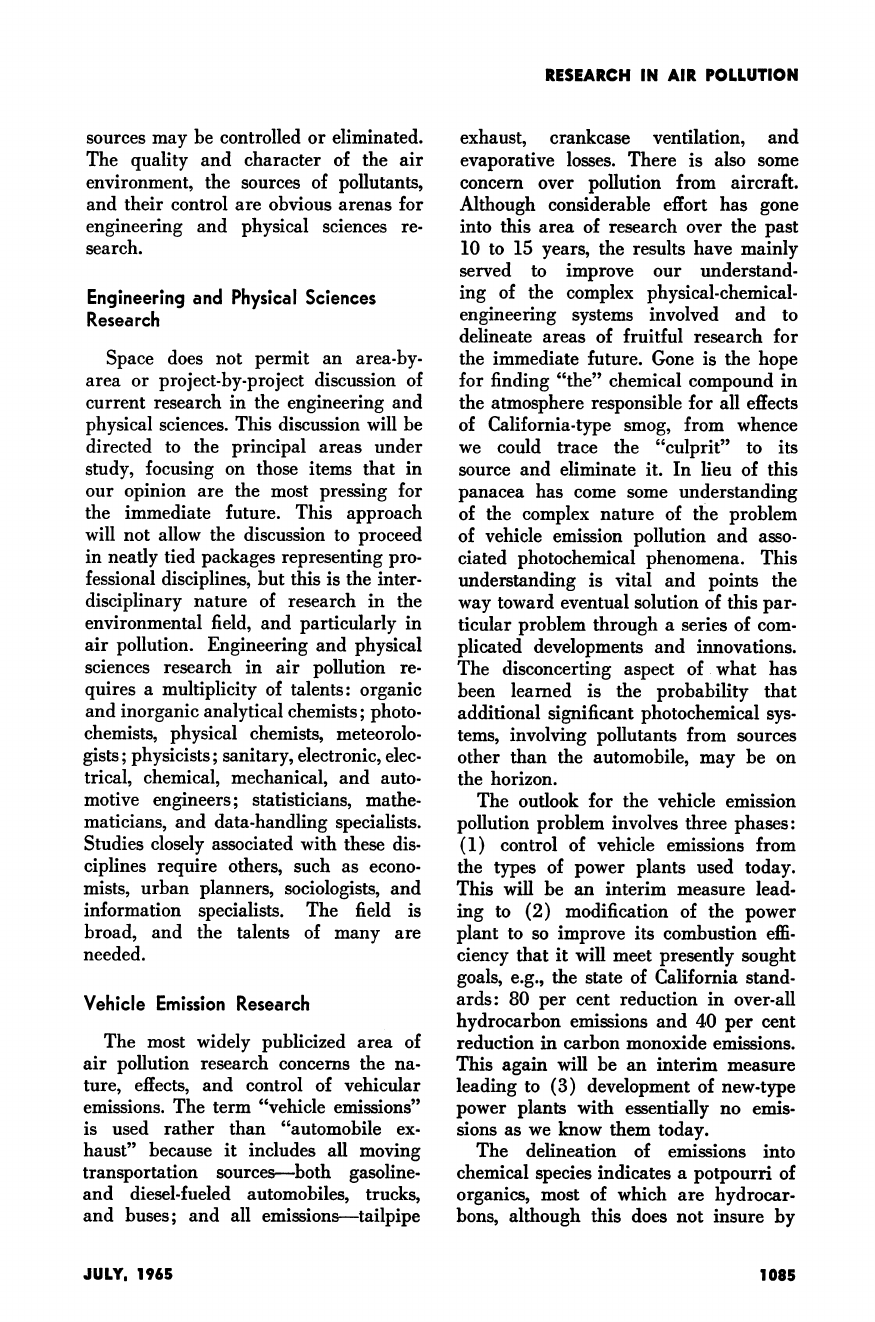
RESEARCH
IN
AIR
POLLUTION
sources
may
be
controlled
or
eliminated.
The
quality
and
character
of
the
air
environment,
the
sources
of
pollutants,
and
their
control
are
obvious
arenas
for
engineering
and
physical
sciences
re-
search.
Engineering
and
Physical
Sciences
Research
Space
does
not
permit
an
area-by-
area
or
project-by-project
discussion
of
current
research
in
the
engineering
and
physical
sciences.
This
discussion
will
be
directed
to
the
principal
areas
under
study,
focusing
on
those
items
that
in
our
opinion
are
the
most
pressing
for
the
immediate
future.
This
approach
will
not
allow
the
discussion
to
proceed
in
neatly
tied
packages
representing
pro-
fessional
disciplines,
but
this
is
the
inter-
disciplinary
nature
of
research
in
the
environmental
field,
and
particularly
in
air
pollution.
Engineering
and
physical
sciences
research
in
air
pollution
re-
quires
a
multiplicity
of
talents:
organic
and
inorganic
analytical
chemists;
photo-
chemists,
physical
chemists,
meteorolo-
gists;
physicists;
sanitary,
electronic,
elec-
trical,
chemical,
mechanical,
and
auto-
motive
engineers;
statisticians,
mathe-
maticians,
and
data-handling
specialists.
Studies
closely
associated
with
these
dis-
ciplines
require
others,
such
as
econo-
mists,
urban
planners,
sociologists,
and
information
specialists.
The
field
is
broad,
and
the
talents
of
many
are
needed.
Vehicle
Emission
Research
The
most
widely
publicized
area
of
air
pollution
research
concerns
the
na-
ture,
effects,
and
control
of
vehicular
emissions.
The
term
"vehicle
emissions"
is
used
rather
than
"automobile
ex-
haust"
because
it
includes
all
moving
transportation
sources-both
gasoline-
and
diesel-fueled
automobiles,
trucks,
and
buses;
and
all
emissions-tailpipe
exhaust,
crankcase
ventilation,
and
evaporative
losses.
There
is
also
some
concern
over
pollution
from
aircraft.
Although
considerable
effort
has
gone
into
this
area
of
research
over
the
past
10
to
15
years,
the
results
have
mainly
served
to
improve
our
understand-
ing
of
the
complex
physical-chemical-
engineering
systems
involved
and
to
delineate
areas
of
fruitful
research
for
the
immediate
future.
Gone
is
the
hope
for
finding
"the"
chemical
compound
in
the
atmosphere
responsible
for
all
effects
of
California-type
smog,
from
whence
we
could
trace
the
"culprit"
to
its
source
and
eliminate
it.
In
lieu
of
this
panacea
has
come
some
understanding
of
the
complex
nature
of
the
problem
of
vehicle
emission
pollution
and
asso-
ciated
photochemical
phenomena.
This
understanding
is
vital
and
points
the
way
toward
eventual
solution
of
this
par-
ticular
problem
through
a
series
of
com-
plicated
developments
and
innovations.
The
disconcerting
aspect
of
what
has
been
learned
is
the
probability
that
additional
significant
photochemical
sys-
tems,
involving
pollutants
from
sources
other
than
the
automobile,
may
be
on
the
horizon.
The
outlook
for
the
vehicle
emission
pollution
problem
involves
three
phases:
(1)
control
of
vehicle
emissions
from
the
types
of
power
plants
used
today.
This
will
be
an
interim
measure
lead-
ing
to
(2)
modification
of
the
power
plant
to
so
improve
its
combustion
effi-
ciency
that
it
will
meet
presently
sought
goals,
e.g.,
the
state
of
California
stand-
ards:
80
per
cent
reduction
in
over-all
hydrocarbon
emissions
and
40
per
cent
reduction
in
carbon
monoxide
emissions.
This
again
will
be
an
interim
measure
leading
to
(3)
development
of
new-type
power
plants
with
essentially
no
emis-
sions
as
we
know
them
today.
The
delineation
of
emissions
into
chemical
species
indicates
a
potpourri
of
organics,
most
of
which
are
hydrocar-
bons,
although
this
does
not
insure
by
JULY.
1965
I
085
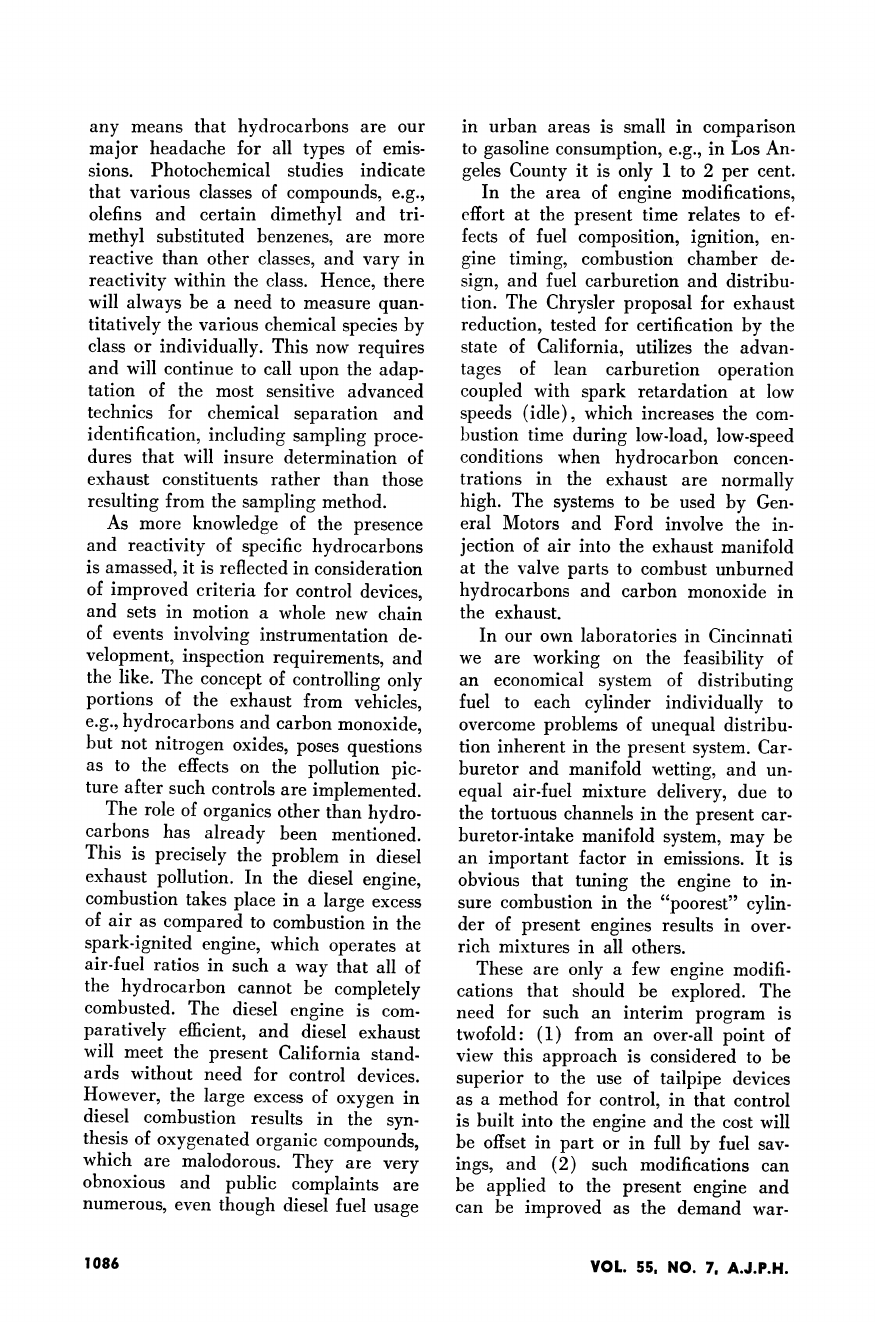
any
means
that
hydrocarbons
are
our
major
headache
for
all
types
of
emis-
sions.
Photochemical
studies
indicate
that
various
classes
of
compounds,
e.g.,
olefins
and
certain
dimethyl
and
tri-
methyl
substituted
benzenes,
are
more
reactive
than
other
classes,
and
vary
in
reactivity
within
the
class.
Hence,
there
will
always
be
a
need
to
measure
quan-
titatively
the
various
chemical
species
by
class
or
individually.
This
now
requires
and
will
continue
to
call
upon
the
adap-
tation
of
the
most
sensitive
advanced
technics
for
chemical
separation
and
identification,
including
sampling
proce-
dures
that
will
insure
determination
of
exhaust
constituents
rather
than
those
resulting
from
the
sampling
method.
As
more
knowledge
of
the
presence
and
reactivity
of
specific
hydrocarbons
is
amassed,
it
is
reflected
in
consideration
of
improved
criteria
for
control
devices,
and
sets
in
motion
a
whole
new
chain
of
events
involving
instrumentation
de-
velopment,
inspection
requirements,
and
the
like.
The
concept
of
controlling
only
portions
of
the
exhaust
from
vehicles,
e.g.,
hydrocarbons
and
carbon
monoxide,
but
not
nitrogen
oxides,
poses
questions
as
to
the
effects
on
the
pollution
pic-
ture
after
such
controls
are
implemented.
The
role
of
organics
other
than
hydro-
carbons
has
already
been
mentioned.
This
is
precisely
the
problem
in
diesel
exhaust
pollution.
In
the
diesel
engine,
combustion
takes
place
in
a
large
excess
of
air
as
compared
to
combustion
in
the
spark-ignited
engine,
which
operates
at
air-fuel
ratios
in
such
a
way
that
all
of
the
hydrocarbon
cannot
be
completely
combusted.
The
diesel
engine
is
com-
paratively
efficient,
and
diesel
exhaust
will
meet
the
present
California
stand-
ards
without
need
for
control
devices.
However,
the
large
excess
of
oxygen
in
diesel
combustion
results
in
the
syn-
thesis
of
oxygenated
organic
compounds,
which
are
malodorous.
They
are
very
obnoxious
and
public
complaints
are
numerous,
even
though
diesel
fuel
usage
in
urban
areas
is
small
in
comparison
to
gasoline
consumption,
e.g.,
in
Los
An-
geles
County
it
is
only
1
to
2
per
cent.
In
the
area
of
engine
modifications,
effort
at
the
present
time
relates
to
ef-
fects
of
fuel
composition,
ignition,
en-
gine
timing,
combustion
chamber
de-
sign,
and
fuel
carburetion
and
distribu-
tion.
The
Chrysler
proposal
for
exhaust
reduction,
tested
for
certification
by
the
state
of
California,
utilizes
the
advan-
tages
of
lean
carburetion
operation
coupled
with
spark
retardation
at
low
speeds
(idle),
which
increases
the
com-
bustion
time
during
low-load,
low-speed
conditions
when
hydrocarbon
concen-
trations
in
the
exhaust
are
normally
high.
The
systems
to
be
used
by
Gen-
eral
Motors
and
Ford
involve
the
in-
jection
of
air
into
the
exhaust
manifold
at
the
valve
parts
to
combust
unburned
hydrocarbons
and
carbon
monoxide
in
the
exhaust.
In
our
own
laboratories
in
Cincinnati
we
are
working
on
the
feasibility
of
an
economical
system
of
distributing
fuel
to
each
cylinder
individually
to
overcome
problems
of
unequal
distribu-
tion
inherent
in
the
present
system.
Car-
buretor
and
manifold
wetting,
and
un-
equal
air-fuel
mixture
delivery,
due
to
the
tortuous
channels
in
the
present
car-
buretor-intake
manifold
system,
may
be
an
important
factor
in
emissions.
It
is
obvious
that
tuning
the
engine
to
in-
sure
combustion
in
the
"poorest"
cylin-
der
of
present
engines
results
in
over-
rich
mixtures
in
all
others.
These
are
only
a
few
engine
modifi-
cations
that
should
be
explored.
The
need
for
such
an
interim
program
is
twofold:
(1)
from
an
over-all
point
of
view
this
approach
is
considered
to
be
superior
to
the
use
of
tailpipe
devices
as
a
method
for
control,
in
that
control
is
built
into
the
engine
and
the
cost
will
be
offset
in
part
or
in
full
by
fuel
sav-
ings,
and
(2)
such
modifications
can
be
applied
to
the
present
engine
and
can
be
improved
as
the
demand
war-
VOL.
55,
NO.
7.
A.J.P.H.
1086
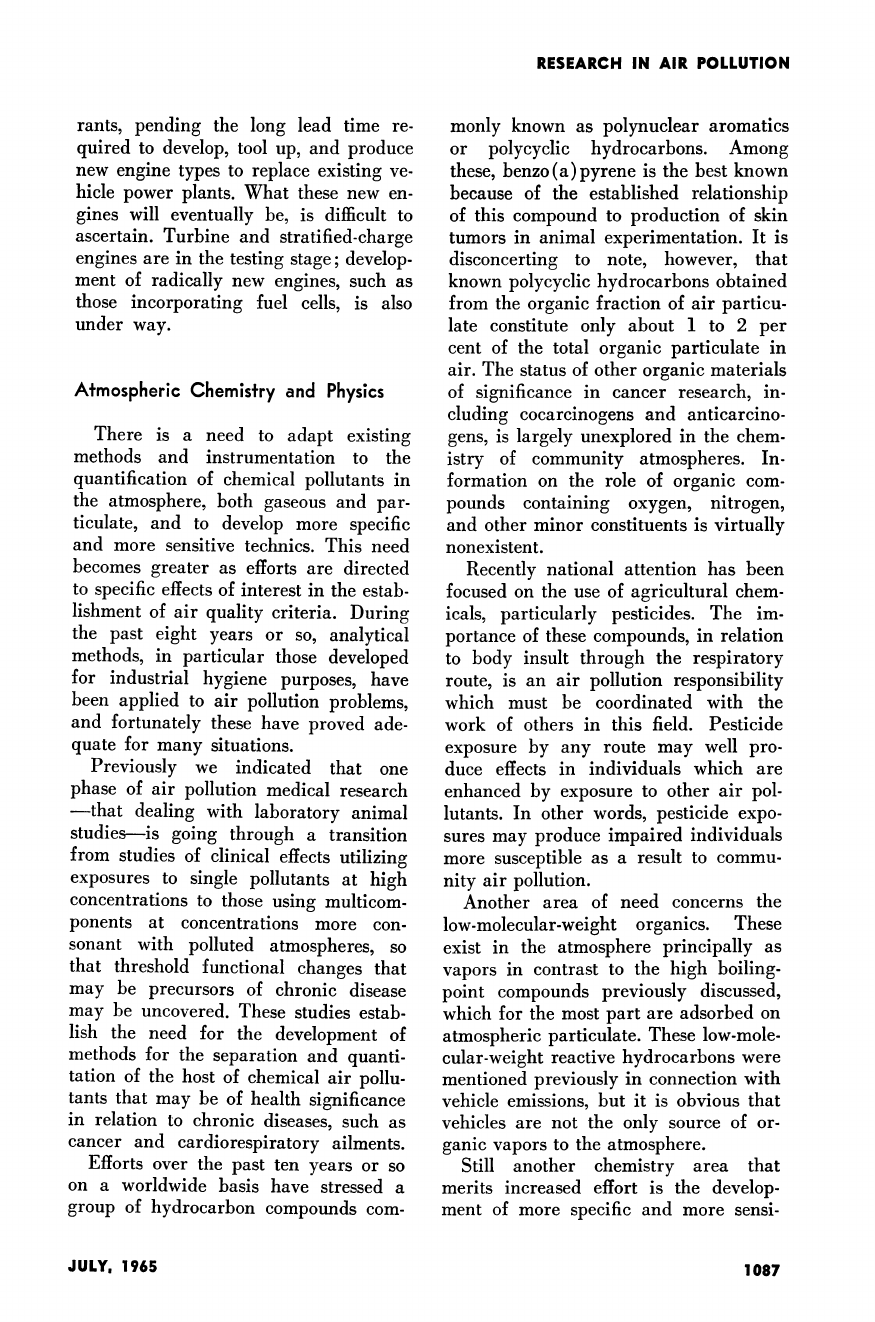
RESEARCH
IN
AIR
POLLUTION
rants,
pending
the
long
lead
time
re-
quired
to
develop,
tool
up,
and
produce
new
engine
types
to
replace
existing
ve-
hicle
power
plants.
What
these
new
en-
gines
will
eventually
be,
is
difficult
to
ascertain.
Turbine
and
stratified-charge
engines
are
in
the
testing
stage;
develop-
ment
of
radically
new
engines,
such
as
those
incorporating
fuel
cells,
is
also
under
way.
Atmospheric
Chemistry
and
Physics
There
is
a
need
to
adapt
existing
methods
and
instrumentation
to
the
quantification
of
chemical
pollutants
in
the
atmosphere,
both
gaseous
and
par-
ticulate,
and
to
develop
more
specific
and
more
sensitive
technics.
This
need
becomes
greater
as
efforts
are
directed
to
specific
effects
of
interest
in
the
estab-
lishment
of
air
quality
criteria.
During
the
past
eight
years
or
so,
analytical
methods,
in
particular
those
developed
for
industrial
hygiene
purposes,
have
been
applied
to
air
pollution
problems,
and
fortunately
these
have
proved
ade-
quate
for
many
situations.
Previously
we
indicated
that
one
phase
of
air
pollution
medical
research
-that
dealing
with
laboratory
animal
studies-is
going
through
a
transition
from
studies
of
clinical
effects
utilizing
exposures
to
single
pollutants
at
high
concentrations
to
those
using
multicom-
ponents
at
concentrations
more
con-
sonant
with
polluted
atmospheres,
so
that
threshold
functional
changes
that
may
be
precursors
of
chronic
disease
may
be
uncovered.
These
studies
estab-
lish
the
need
for
the
development
of
methods
for
the
separation
and
quanti-
tation
of
the
host
of
chemical
air
pollu-
tants
that
may
be
of
health
significance
in
relation
to
chronic
diseases,
such
as
cancer
and
cardiorespiratory
ailments.
Efforts
over
the
past
ten
years
or
so
on
a
worldwide
basis
have
stressed
a
group
of
hydrocarbon
compounds
com-
monly
known
as
polynuclear
aromatics
or
polycyclic
hydrocarbons.
Among
these,
benzo(a)pyrene
is
the
best
known
because
of
the
established
relationship
of
this
compound
to
production
of
skin
tumors
in
animal
experimentation.
It
is
disconcerting
to
note,
however,
that
known
polycyclic
hydrocarbons
obtained
from
the
organic
fraction
of
air
particu-
late
constitute
only
about
1
to
2
per
cent
of
the
total
organic
particulate
in
air.
The
status
of
other
organic
materials
of
significance
in
cancer
research,
in-
cluding
cocarcinogens
and
anticarcino-
gens,
is
largely
unexplored
in
the
chem-
istry
of
community
atmospheres.
In-
formation
on
the
role
of
organic
com-
pounds
containing
oxygen,
nitrogen,
and
other
minor
constituents
is
virtually
nonexistent.
Recently
national
attention
has
been
focused
on
the
use
of
agricultural
chem-
icals,
particularly
pesticides.
The
im-
portance
of
these
compounds,
in
relation
to
body
insult
through
the
respiratory
route,
is
an
air
pollution
responsibility
which
must
be
coordinated
with
the
work
of
others
in
this
field.
Pesticide
exposure
by
any
route
may
well
pro-
duce
effects
in
individuals
which
are
enhanced
by
exposure
to
other
air
pol-
lutants.
In
other
words,
pesticide
expo-
sures
may
produce
impaired
individuals
more
susceptible
as
a
result
to
commu-
nity
air
pollution.
Another
area
of
need
concerns
the
low-molecular-weight
organics.
These
exist
in
the
atmosphere
principally
as
vapors
in
contrast
to
the
high
boiling-
point
compounds
previously
discussed,
which
for
the
most
part
are
adsorbed
on
atmospheric
particulate.
These
low-mole-
cular-weight
reactive
hydrocarbons
were
mentioned
previously
in
connection
with
vehicle
emissions,
but
it
is
obvious
that
vehicles
are
not
the
only
source
of
or-
ganic
vapors
to
the
atmosphere.
Still
another
chemistry
area
that
merits
increased
effort
is
the
develop-
ment
of
more
specific
and
more
sensi-
JULY.
1965
1
087
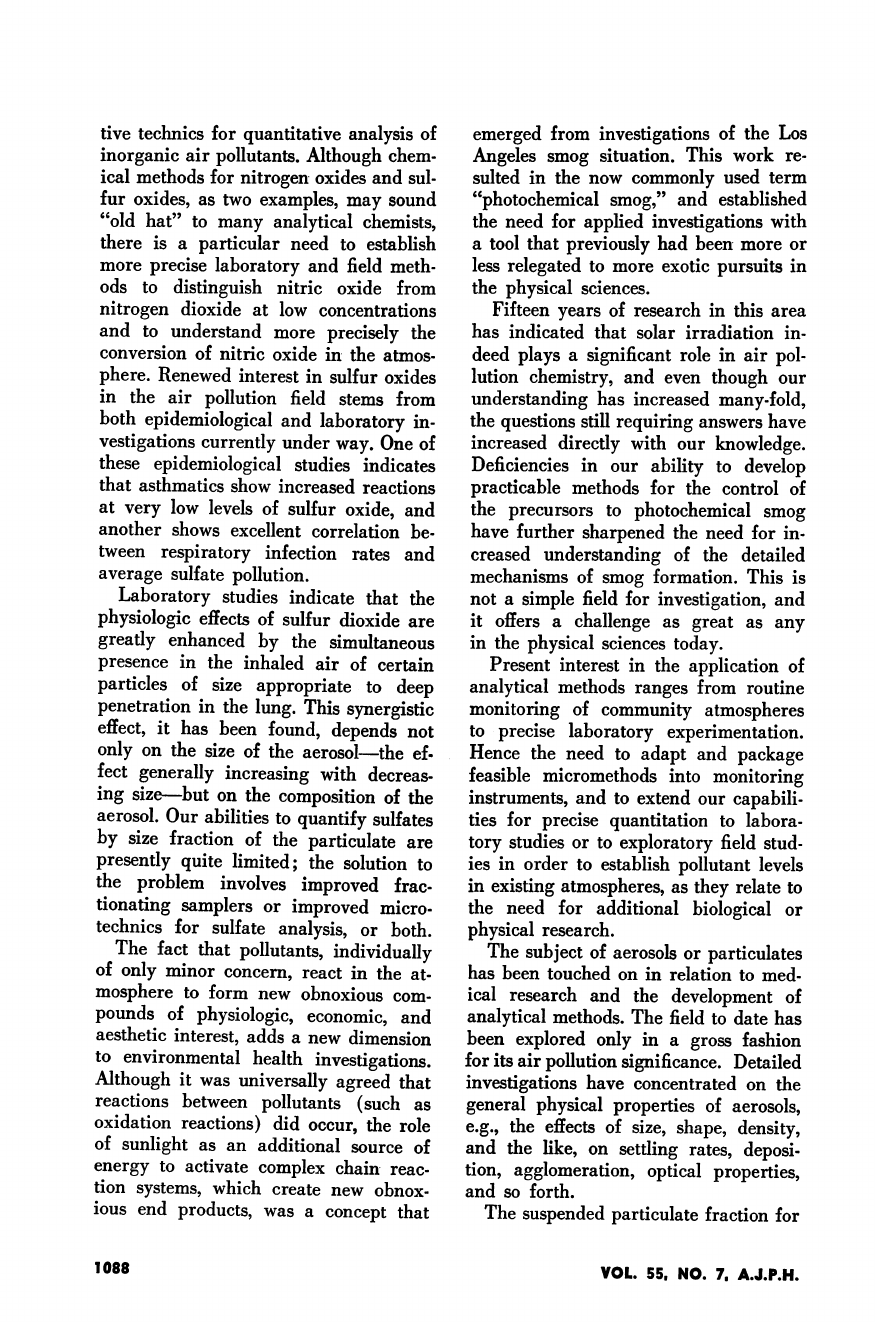
tive
technics
for
quantitative
analysis
of
inorganic
air
pollutants.
Although
chem-
ical
methods
for
nitrogen
oxides
and
sul-
fur
oxides,
as
two
examples,
may
sound
"old
hat"
to
many
analytical
chemists,
there
is
a
particular
need
to
establish
more
precise
laboratory
and
field
meth-
ods
to
distinguish
nitric
oxide
from
nitrogen
dioxide
at
low
concentrations
and
to
understand
more
precisely
the
conversion
of
nitric
oxide
in
the
atmos-
phere.
Renewed
interest
in
sulfur
oxides
in
the
air
pollution
field
stems
from
both
epidemiological
and
laboratory
in-
vestigations
currently
under
way.
One
of
these
epidemiological
studies
indicates
that
asthmatics
show
increased
reactions
at
very
low
levels
of
sulfur
oxide,
and
another
shows
excellent
correlation
be-
tween
respiratory
infection
rates
and
average
sulfate
pollution.
Laboratory
studies
indicate
that
the
physiologic
effects
of
sulfur
dioxide
are
greatly
enhanced
by
the
simultaneous
presence
in
the
inhaled
air
of
certain
particles
of
size
appropriate
to
deep
penetration
in
the
lung.
This
synergistic
effect,
it
has
been
found,
depends
not
only
on
the
size
of
the
aerosol-the
ef-
fect
generally
increasing
with
decreas-
ing
size-but
on
the
composition
of
the
aerosol.
Our
abilities
to
quantify
sulfates
by
size
fraction
of
the
particulate
are
presently
quite
limited;
the
solution
to
the
problem
involves
improved
frac-
tionating
samplers
or
improved
micro-
technics
for
sulfate
analysis,
or
both.
The
fact
that
pollutants,
individually
of
only
minor
concern,
react
in
the
at-
mosphere
to
form
new
obnoxious
com-
pounds
of
physiologic,
economic,
and
aesthetic
interest,
adds
a
new
dimension
to
environmental
health
investigations.
Although
it
was
universally
agreed
that
reactions
between
pollutants
(such
as
oxidation
reactions)
did
occur,
the
role
of
sunlight
as
an
additional
source
of
energy
to
activate
complex
chain
reac-
tion
systems,
which
create
new
obnox-
ious
end
products,
was
a
concept
that
emerged
from
investigations
of
the
Los
Angeles
smog
situation.
This
work
re-
sulted
in
the
now
commonly
used
term
"photochemical
smog,"
and
established
the
need
for
applied
investigations
with
a
tool
that
previously
had
been
more
or
less
relegated
to
more
exotic
pursuits
in
the
physical
sciences.
Fifteen
years
of
research
in
this
area
has
indicated
that
solar
irradiation
in-
deed
plays
a
significant
role
in
air
pol-
lution
chemistry,
and
even
though
our
understanding
has
increased
many-fold,
the
questions
still
requiring
answers
have
increased
directly
with
our
knowledge.
Deficiencies
in
our
ability
to
develop
practicable
methods
for
the
control
of
the
precursors
to
photochemical
smog
have
further
sharpened
the
need
for
in-
creased
understanding
of
the
detailed
mechanisms
of
smog
formation.
This
is
not
a
simple
field
for
investigation,
and
it
offers
a
challenge
as
great
as
any
in
the
physical
sciences
today.
Present
interest
in
the
application
of
analytical
methods
ranges
from
routine
monitoring
of
community
atmospheres
to
precise
laboratory
experimentation.
Hence
the
need
to
adapt
and
package
feasible
micromethods
into
monitoring
instruments,
and
to
extend
our
capabili-
ties
for
precise
quantitation
to
labora-
tory
studies
or
to
exploratory
field
stud-
ies
in
order
to
establish
pollutant
levels
in
existing
atmospheres,
as
they
relate
to
the
need
for
additional
biological
or
physical
research.
The
subject
of
aerosols
or
particulates
has
been
touched
on
in
relation
to
med-
ical
research
and
the
development
of
analytical
methods.
The
field
to
date
has
been
explored
only
in
a
gross
fashion
for
its
air
pollution
significance.
Detailed
investigations
have
concentrated
on
the
general
physical
properties
of
aerosols,
e.g.,
the
effects
of
size,
shape,
density,
and
the
like,
on
settling
rates,
deposi-
tion,
agglomeration,
optical
properties,
and
so
forth.
The
suspended
particulate
fraction
for
VOL.
55,
NO.
7.
A.J.P.H.
1088
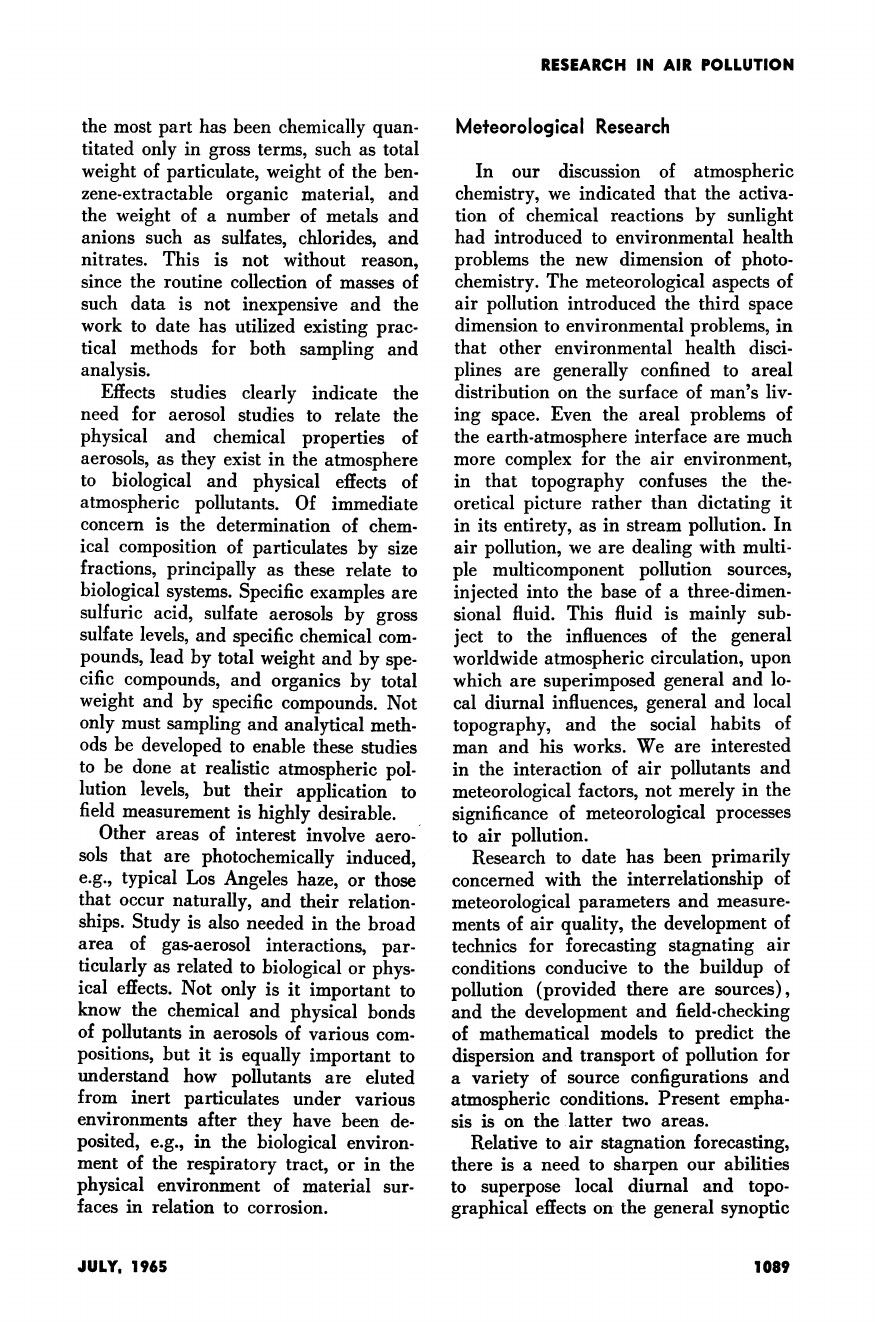
RESEARCH
IN
AIR
POLLUTION
the
most
part
has
been
chemically
quan-
titated
only
in
gross
terms,
such
as
total
weight
of
particulate,
weight
of
the
ben-
zene-extractable
organic
material,
and
the
weight
of
a
number
of
metals
and
anions
such
as
sulfates,
chlorides,
and
nitrates.
This
is
not
without
reason,
since
the
routine
collection
of
masses
of
such
data
is
not
inexpensive
and
the
work
to
date
has
utilized
existing
prac-
tical
methods
for
both
sampling
and
analysis.
Effects
studies
clearly
indicate
the
need
for
aerosol
studies
to
relate
the
physical
and
chemical
properties
of
aerosols,
as
they
exist
in
the
atmosphere
to
biological
and
physical
effects
of
atmospheric
pollutants.
Of
immediate
concern
is
the
determination
of
chem-
ical
composition
of
particulates
by
size
fractions,
principally
as
these
relate
to
biological
systems.
Specific
examples
are
sulfuric
acid,
sulfate
aerosols
by
gross
sulfate
levels,
and
specific
chemical
com-
pounds,
lead
by
total
weight
and
by
spe-
cific
compounds,
and
organics
by
total
weight
and
by
specific
compounds.
Not
only
must
sampling
and
analytical
meth-
ods
be
developed
to
enable
these
studies
to
be
done
at
realistic
atmospheric
pol-
lution
levels,
but
their
application
to
field
measurement
is
highly
desirable.
Other
areas
of
interest
involve
aero-
sols
that
are
photochemically
induced,
e.g.,
typical
Los
Angeles
haze,
or
those
that
occur
naturally,
and
their
relation-
ships.
Study
is
also
needed
in
the
broad
area
of
gas-aerosol
interactions,
par-
ticularly
as
related
to
biological
or
phys-
ical
effects.
Not
only
is
it
important
to
know
the
chemical
and
physical
bonds
of
pollutants
in
aerosols
of
various
com-
positions,
but
it
is
equally
important
to
understand
how
pollutants
are
eluted
from
inert
particulates
under
various
environments
after
they
have
been
de-
posited,
e.g.,
in
the
biological
environ-
ment
of
the
respiratory
tract,
or
in
the
physical
environment
of
material
sur-
faces
in
relation
to
corrosion.
Meteorological
Research
In
our
discussion
of
atmospheric
chemistry,
we
indicated
that
the
activa-
tion
of
chemical
reactions
by
sunlight
had
introduced
to
environmental
health
problems
the
new
dimension
of
photo-
chemistry.
The
meteorological
aspects
of
air
pollution
introduced
the
third
space
dimension
to
environmental
problems,
in
that
other
environmental
health
disci-
plines
are
generally
confined
to
areal
distribution
on
the
surface
of
man's
liv-
ing
space.
Even
the
areal
problems
of
the
earth-atmosphere
interface
are
much
more
complex
for
the
air
environment,
in
that
topography
confuses
the
the-
oretical
picture
rather
than
dictating
it
in
its
entirety,
as
in
stream
pollution.
In
air
pollution,
we
are
dealing
with
multi-
ple
multicomponent
pollution
sources,
injected
into
the
base
of
a
three-dimen-
sional
fluid.
This
fluid
is
mainly
sub-
ject
to
the
influences
of
the
general
worldwide
atmospheric
circulation,
upon
which
are
superimposed
general
and
lo-
cal
diurnal
influences,
general
and
local
topography,
and
the
social
habits
of
man
and
his
works.
We
are
interested
in
the
interaction
of
air
pollutants
and
meteorological
factors,
not
merely
in
the
significance
of
meteorological
processes
to
air
pollution.
Research
to
date
has
been
primarily
concerned
with
the
interrelationship
of
meteorological
parameters
and
measure-
ments
of
air
quality,
the
development
of
technics
for
forecasting
stagnating
air
conditions
conducive
to
the
buildup
of
pollution
(provided
there
are
sources),
and
the
development
and
field-checking
of
mathematical
models
to
predict
the
dispersion
and
transport
of
pollution
for
a
variety
of
source
configurations
and
atmospheric
conditions.
Present
empha-
sis
is
on
the
latter
two
areas.
Relative
to
air
stagnation
forecasting,
there
is
a
need
to
sharpen
our
abilities
to
superpose
local
diurnal
and
topo-
graphical
effects
on
the
general
synoptic
JULY.
1965
1
089
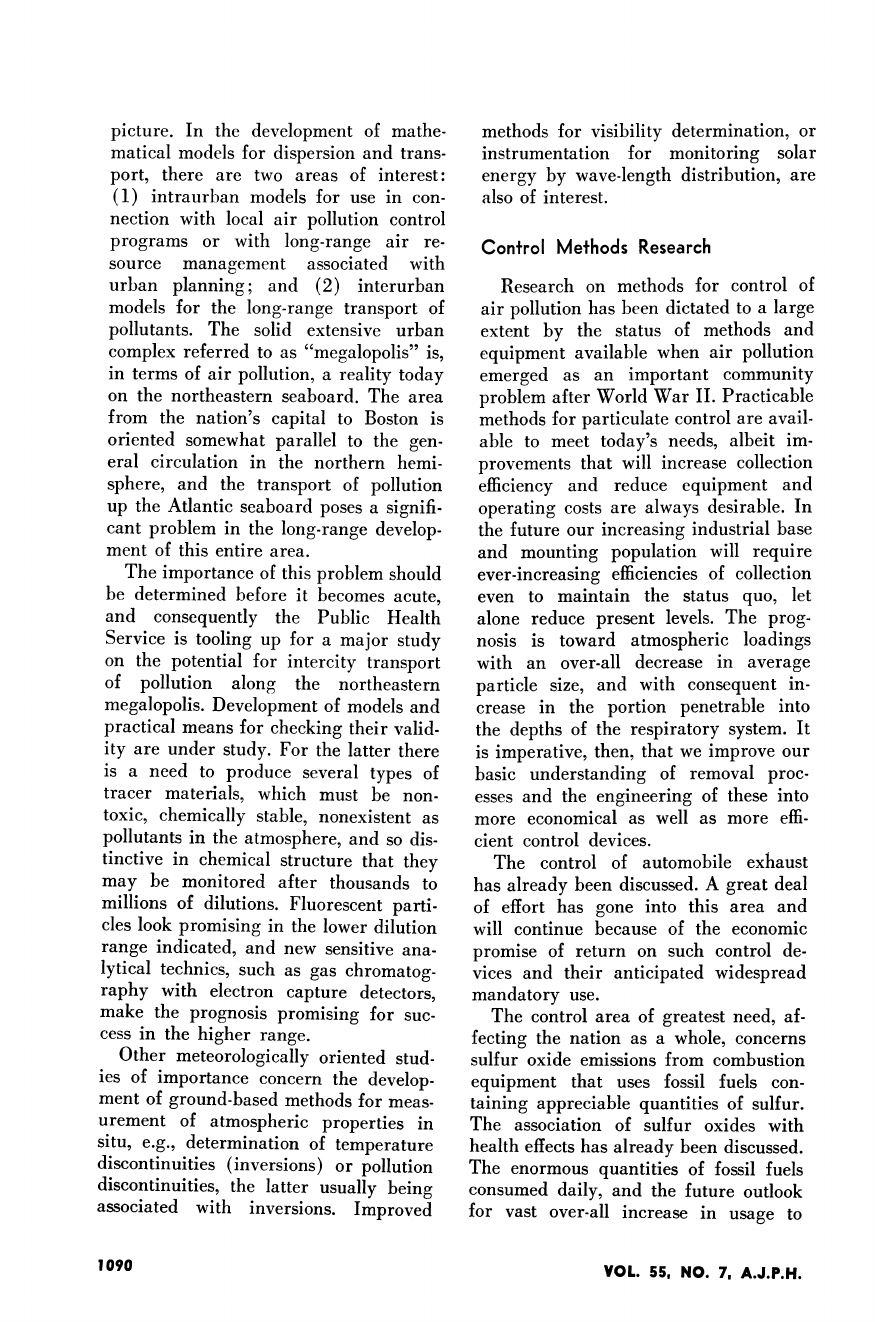
picture.
In
the
development
of
mathe-
matical
models
for
dispersion
and
trans-
port,
there
are
two
areas
of
interest:
(1)
intraurban
models
for
use
in
con-
nection
with
local
air
pollution
control
programs
or
with
long-range
air
re-
source
management
associated
with
urban
planning;
and
(2)
interurban
models
for
the
long-range
transport
of
pollutants.
The
solid
extensive
urban
complex
referred
to
as
"megalopolis"
is,
in
terms
of
air
pollution,
a
reality
today
on
the
northeastern
seaboard.
The
area
from
the
nation's
capital
to
Boston
is
oriented
somewhat
parallel
to
the
gen-
eral
circulation
in
the
northern
hemi-
sphere,
and
the
transport
of
pollution
up
the
Atlantic
seaboard
poses
a
signifi-
cant
problem
in
the
long-range
develop-
ment
of
this
entire
area.
The
importance
of
this
problem
should
be
determined
before
it
becomes
acute,
and
consequently
the
Public
Health
Service
is
tooling
up
for
a
major
study
on
the
potential
for
intercity
transport
of
pollution
along
the
northeastern
megalopolis.
Development
of
models
and
practical
means
for
checking
their
valid-
ity
are
under
study.
For
the
latter
there
is
a
need
to
produce
several
types
of
tracer
materials,
which
must
be
non-
toxic,
chemically
stable,
nonexistent
as
pollutants
in
the
atmosphere,
and
so
dis-
tinctive
in
chemical
structure
that
they
may
be
monitored
after
thousands
to
millions
of
dilutions.
Fluorescent
parti-
cles
look
promising
in
the
lower
dilution
range
indicated,
and
new
sensitive
ana-
lytical
technics,
such
as
gas
chromatog-
raphy
with
electron
capture
detectors,
make
the
prognosis
promising
for
suc-
cess
in
the
higher
range.
Other
meteorologically
oriented
stud-
ies
of
importance
concern
the
develop-
ment
of
ground-based
methods
for
meas-
urement
of
atmospheric
properties
in
situ,
e.g.,
determination
of
temperature
discontinuities
(inversions)
or
pollution
discontinuities,
the
latter
usually
being
associated
with
inversions.
Improved
methods
for
visibility
determination,
or
instrumentation
for
monitoring
solar
energy
by
wave-length
distribution,
are
also
of
interest.
Control
Methods
Research
Research
on
methods
for
control
of
air
pollution
has
been
dictated
to
a
large
extent
by
the
status
of
methods
and
equipment
available
when
air
pollution
emerged
as
an
important
community
problem
after
World
War
II.
Practicable
methods
for
particulate
control
are
avail-
able
to
meet
today's
needs,
albeit
im-
provements
that
will
increase
collection
efficiency
and
reduce
equipment
and
operating
costs
are
always
desirable.
In
the
future
our
increasing
industrial
base
and
mounting
population
will
require
ever-increasing
efficiencies
of
collection
even
to
maintain
the
status
quo,
let
alone
reduce
present
levels.
The
prog-
nosis
is
toward
atmospheric
loadings
with
an
over-all
decrease
in
average
particle
size,
and
with
consequent
in-
crease
in
the
portion
penetrable
into
the
depths
of
the
respiratory
system.
It
is
imperative,
then,
that
we
improve
our
basic
understanding
of
removal
proc-
esses
and
the
engineering
of
these
into
more
economical
as
well
as
more
effi-
cient
control
devices.
The
control
of
automobile
exhaust
has
already
been
discussed.
A
great
deal
of
effort
has
gone
into
this
area
and
will
continue
because
of
the
economic
promise
of
return
on
such
control
de-
vices
and
their
anticipated
widespread
mandatory
use.
The
control
area
of
greatest
need,
af-
fecting
the
nation
as
a
whole,
concerns
sulfur
oxide
emissions
from
combustion
equipment
that
uses
fossil
fuels
con-
taining
appreciable
quantities
of
sulfur.
The
association
of
sulfur
oxides
with
health
effects
has
already
been
discussed.
The
enormous
quantities
of
fossil
fuels
consumed
daily,
and
the
future
outlook
for
vast
over-all
increase
in
usage
to
VOL.
55.
NO.
7.
A.J.P.H.
l
090
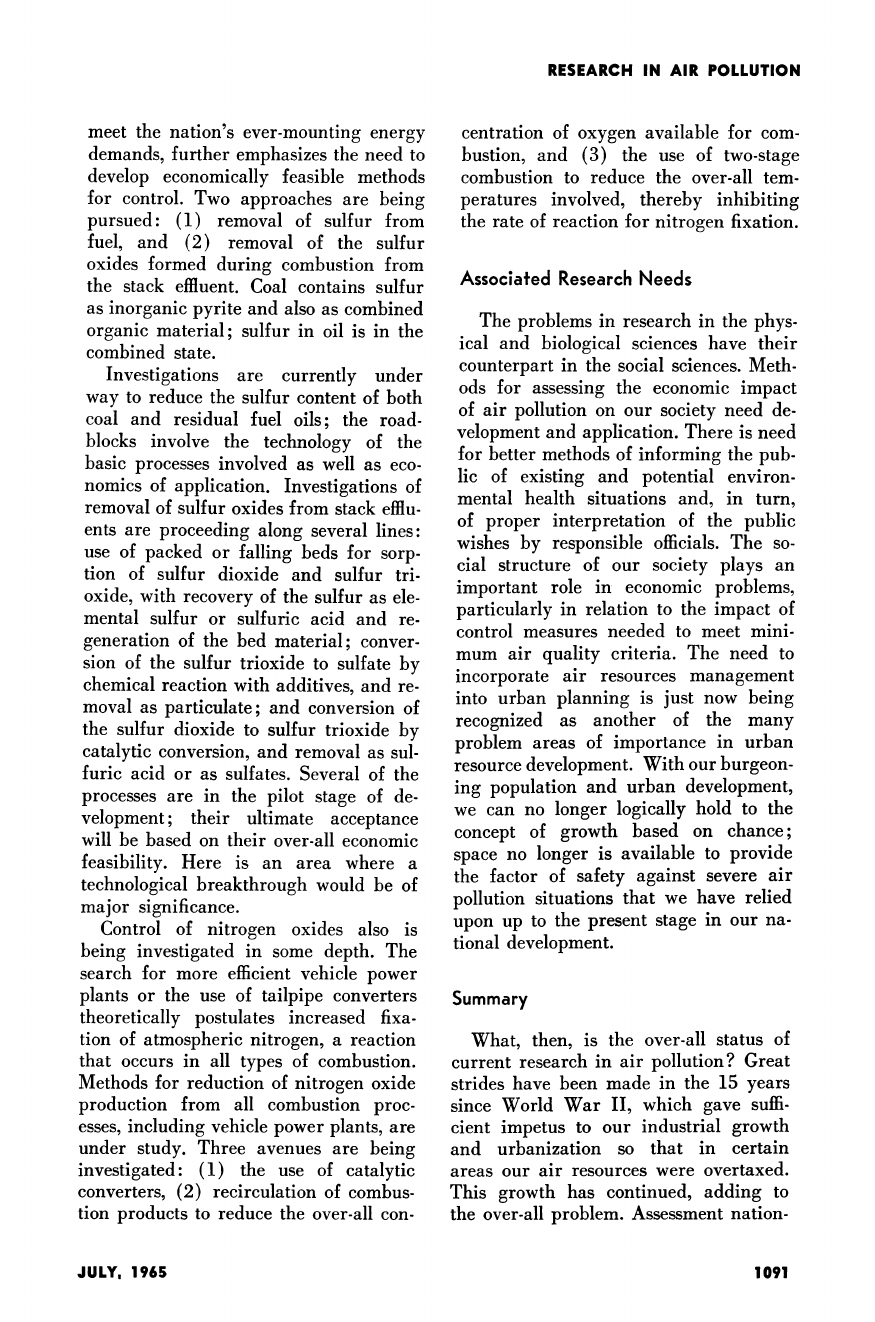
RESEARCH
IN
AIR
POLLUTION
meet
the
nation's
ever-mounting
energy
demands,
further
emphasizes
the
need
to
develop
economically
feasible
methods
for
control.
Two
approaches
are
being
pursued:
(1)
removal
of
sulfur
from
fuel,
and
(2)
removal
of
the
sulfur
oxides
formed
during
combustion
from
the
stack
effluent.
Coal
contains
sulfur
as
inorganic
pyrite
and
also
as
combined
organic
material;
sulfur
in
oil
is
in
the
combined
state.
Investigations
are
currently
under
way
to
reduce
the
sulfur
content
of
both
coal
and
residual
fuel
oils;
the
road-
blocks
involve
the
technology
of
the
basic
processes
involved
as
well
as
eco-
nomics
of
application.
Investigations
of
removal
of
sulfur
oxides
from
stack
efflu-
ents
are
proceeding
along
several
lines:
use
of
packed
or
falling
beds
for
sorp-
tion
of
sulfur
dioxide
and
sulfur
tri-
oxide,
with
recovery
of
the
sulfur
as
ele-
mental
sulfur
or
sulfuric
acid
and
re-
generation
of
the
bed
material;
conver-
sion
of
the
sulfur
trioxide
to
sulfate
by
chemical
reaction
with
additives,
and
re-
moval
as
particulate;
and
conversion
of
the
sulfur
dioxide
to
sulfur
trioxide
by
catalytic
conversion,
and
removal
as
sul-
furic
acid
or
as
sulfates.
Several
of
the
processes
are
in
the
pilot
stage
of
de-
velopment;
their
ultimate
acceptance
will
be
based
on
their
over-all
economic
feasibility.
Here
is
an
area
where
a
technological
breakthrough
would
be
of
major
significance.
Control
of
nitrogen
oxides
also
is
being
investigated
in
some
depth.
The
search
for
more
efficient
vehicle
power
plants
or
the
use
of
tailpipe
converters
theoretically
postulates
increased
fixa-
tion
of
atmospheric
nitrogen,
a
reaction
that
occurs
in
all
types
of
combustion.
Methods
for
reduction
of
nitrogen
oxide
production
from
all
combustion
proc-
esses,
including
vehicle
power
plants,
are
under
study.
Three
avenues
are
being
investigated:
(1)
the
use
of
catalytic
converters,
(2)
recirculation
of
combus-
tion
products
to
reduce
the
over-all
con-
centration
of
oxygen
available
for
com-
bustion,
and
(3)
the
use
of
two-stage
combustion
to
reduce
the
over-all
tem-
peratures
involved,
thereby
inhibiting
the
rate
of
reaction
for
nitrogen
fixation.
Associated
Research
Needs
The
problems
in
research
in
the
phys-
ical
and
biological
sciences
have
their
counterpart
in
the
social
sciences.
Meth-
ods
for
assessing
the
economic
impact
of
air
pollution
on
our
society
need
de-
velopment
and
application.
There
is
need
for
better
methods
of
informing
the
pub-
lic
of
existing
and
potential
environ-
mental
health
situations
and,
in
turn,
of
proper
interpretation
of
the
public
wishes
by
responsible
officials.
The
so-
cial
structure
of
our
society
plays
an
important
role
in
economic
problems,
particularly
in
relation
to
the
impact
of
control
measures
needed
to
meet
mini-
mum
air
quality
criteria.
The
need
to
incorporate
air
resources
management
into
urban
planning
is
just
now
being
recognized
as
another
of
the
many
problem
areas
of
importance
in
urban
resource
development.
With
our
burgeon-
ing
population
and
urban
development,
we
can
no
longer
logically
hold
to
the
concept
of
growth
based
on
chance;
space
no
longer
is
available
to
provide
the
factor
of
safety
against
severe
air
pollution
situations
that
we
have
relied
upon
up
to
the
present
stage
in
our
na-
tional
development.
Summary
What,
then,
is
the
over-all
status
of
current
research
in
air
pollution?
Great
strides
have
been
made
in
the
15
years
since
World
War
II,
which
gave
suffi-
cient
impetus
to
our
industrial
growth
and
urbanization
so
that
in
certain
areas
our
air
resources
were
overtaxed.
This
growth
has
continued,
adding
to
the
over-all
problem.
Assessment
nation-
JULY.
1965
1091
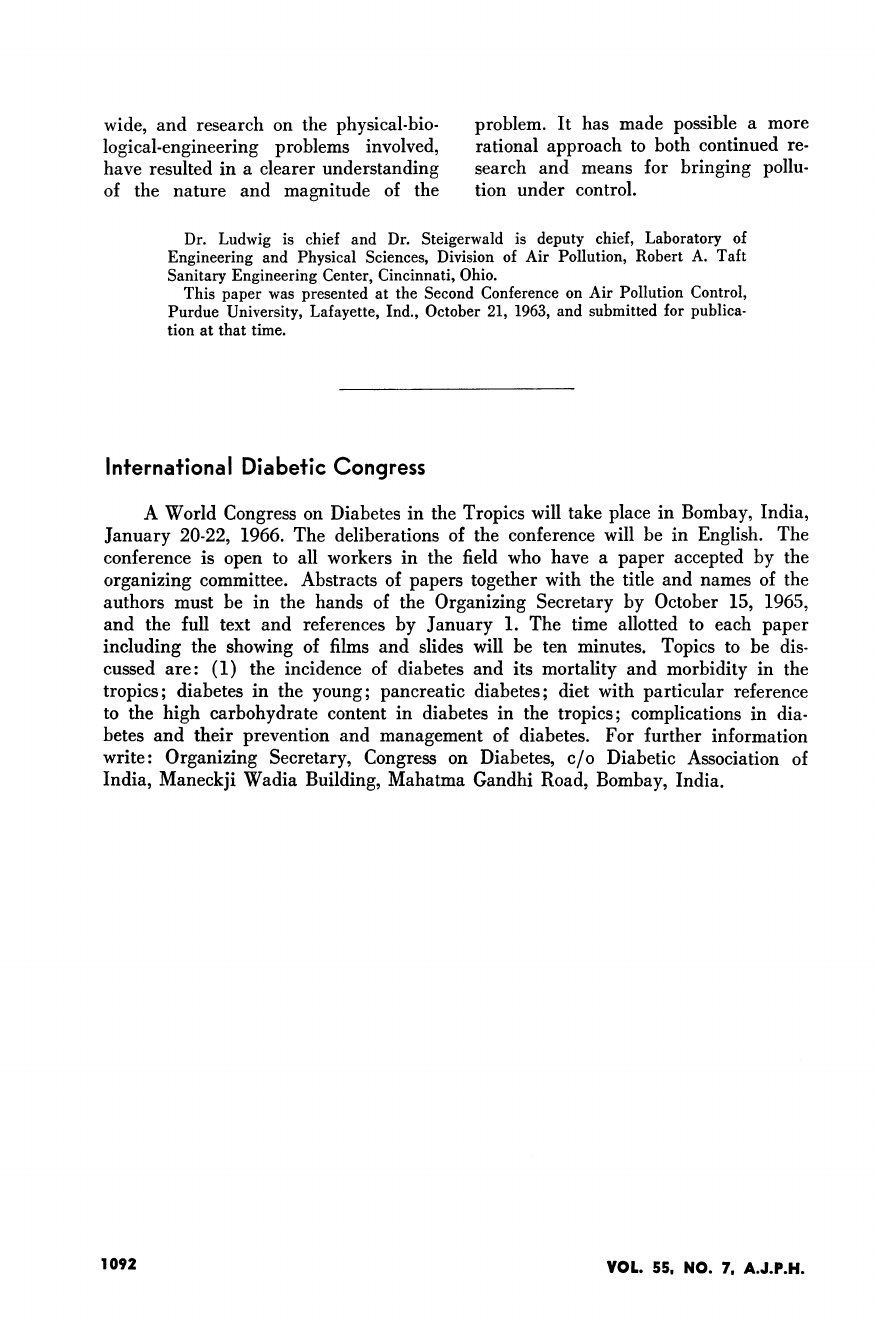
wide,
and
research
on
the
physical-bio-
problem.
It
has
made
possible
a
more
logical-engineering
problems
involved,
rational
approach
to
both
continued
re-
have
resulted
in
a
clearer
understanding
search
and
means
for
bringing
pollu-
of
the
nature
and
magnitude
of
the
tion
under
control.
Dr.
Ludwig
is
chief
and
Dr.
Steigerwald
is
deputy
chief,
Laboratory
of
Engineering
and
Physical
Sciences,
Division
of
Air
Pollution,
Robert
A.
Taft
Sanitary
Engineering
Center,
Cincinnati,
Ohio.
This
paper
was
presented
at
the
Second
Conference
on
Air
Pollution
Control,
Purdue
University,
Lafayette,
Ind.,
October
21,
1963,
and
submitted
for
publica-
tion
at
that
time.
International
Diabetic
Congress
A
World
Congress
on
Diabetes
in
the
Tropics
will
take
place
in
Bombay,
India,
January
20-22,
1966.
The
deliberations
of
the
conference
will
be
in
English.
The
conference
is
open
to
all
workers
in
the
field
who
have
a
paper
accepted
by
the
organizing
committee.
Abstracts
of
papers
together
with
the
title
and
names
of
the
authors
must
be
in
the
hands
of
the
Organizing
Secretary
by
October
15,
1965,
and
the
full
text
and
references
by
January
1.
The
time
allotted
to
each
paper
including
the
showing
of
films
and
slides
will
be
ten
minutes.
Topics
to
be
dis-
cussed
are:
(1)
the
incidence
of
diabetes
and
its
mortality
and
morbidity
in
the
tropics;
diabetes
in
the
young;
pancreatic
diabetes;
diet
with
particular
reference
to
the
high
carbohydrate
content
in
diabetes
in
the
tropics;
complications
in
dia-
betes
and
their
prevention
and
management
of
diabetes.
For
further
information
write:
Organizing
Secretary,
Congress
on
Diabetes,
c/o
Diabetic
Association
of
India,
Maneckji
Wadia
Building,
Mahatma
Gandhi
Road,
Bombay,
India.
VOL.
55,
NO.
7,
A.J.P.H.
1092
